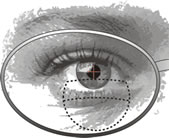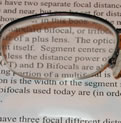|
Lens Styles
There are a variety of lens styles available and you
must specify the type of lens as well as the material you require. The
most common lens types are:
Single Vision
Single vision lenses have only one focal length they are
corrected to. This is traditionally for distance, but it can be set for
near, or intermediate. The optical center of a single vision lens is the
thinnest part of a minus lens and the thickest part of a plus lens.
Bifocals
Bifocals have two separate focal distances they are
corrected to. This is traditionally distance and near, but can be set
for distance and intermediate, or intermediate and near. Shown later in
this book are the most common styles. The distance optical center of a
standard bifocal, or trifocal lens is the thinnest part of a minus lens
and the thickest part of a plus lens. The optical center of the segment
is a preset depth into the segment itself. Segment centers cannot be
spotted on a lensometer for bifocals, or trifocals unless the distance
power of the lens is Plano, or 0.00. Straight Top (ST), Flat Top (FT)
and D Bifocals are all different manufacturer names for the same thing.
The reading portion of a multifocal is called the “Add”, or the segment.
The number designation is the width of the segment measured at its
widest part. The most common bifocals used today are (in order): ST 28,
ST 35, Round 25, or round 28 and Executive.
Return to Top
Trifocals

Trifocals have three focal different distances they are
corrected to. The intermediate is traditionally set at 50% of the total
add power, but can be adjusted in some styles to accommodate different
working distances. Straight Top Trifocal (STT), Flat Top Trifocal (FTT)
and D Trifocals are all different manufacturers names for the same
thing. The first number in a trifocal gives the height measured from the
top of the bifocal part of the segment to the top of the trifocal
portion. The second number is the width of the segment measured at its
widest part. The most common trifocals used today are (in order): STT
7x28, STT 8x35, STT 10x35 and the Executive Trifocal. The lens
identified as a Trifield is more commonly called an Executive Trifocal.
Progressive Power
Lenses
Progressives provide the three focal different distances
that you get from trifocals, but do it in a continuous, gradually
increasing manner, rather than jumping from focal area to focal area
like a bifocal, or trifocal. Today’s new computer corrected designs
offer excellent vision and much wider optical zones than in the past. In
addition there are some specialty progressives designed for small frames
such as the Varilux® Panamic, Solamax, AO Compact and Outlook. Most
progressives (not all) come with scratch coating. Check with your lab to
see if this requires an additional charge. The most accurate method for
telling what the add power of a progressive power lens is to locate the
temporal side layout marking. Just under this mark, the manufacturer
will have engraved the add power.
Return to Top
Occupational
Lenses
Occupational lenses serve special purposes, having an
additional segment at the top of the lens allowing the patient to see at
near above as well as below and are often called “double segs’. If the
bottom portion is a trifocal the lens is called a quadrafocal. The
standard separation between the top and bottom segments is 13-14 mm and
the upper seg can be bifocal, or trifocal strength.
Aphakic
Better known as cataract lenses, aphakics are very high
power lenses that were once the only way to restore sight when the
patient’s own crystalline lens clouded (a cataract), and was surgically
removed from the eye. Modern techniques now allow the surgeon to implant
into the eye a substitute lens when surgery is performed, and as a
result aphakic lenses are declining in usage. Aphakics however are still
available in a variety of styles. Aspheric styles (many curves on the
same surface) are preferred for clearer sight in both single vision and
multifocal. The style shown is an aspheric lenticular with a round
bifocal and looks like a large button on a flat lens
Computer Lenses

Most of these lenses have distance and others do not. The main
purpose is to provide intermediate (arms length) in the upper
portion of the lens and standard reading power in the bottom. Do not
let their designation as Computer Lenses confine you to computer use
only. Anyone whose work/hobby visual requirements are higher than
normal will benefit from these designs, generally as a second pair.
Examples: mechanics, cooking, crafts, music, shooting pool etc..
Return to Top
|